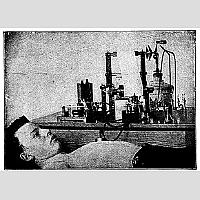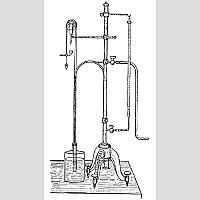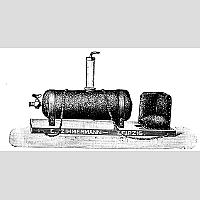 |
|
 |
 |
 |
Armrest-tripod for the forearm. The upholstered rest is screwed on to the tabe and is optionally height-adjustable to guarantee the correct fixing of the forearm and the hand. The tripod serves for experiments in the pulse and facilitates the operations of all sphygmographs, pulsophones etc. 2,100 kg.
(Armauflage-Stativ für den Unterarm)
|
1922 |
|
taken from: Zimmermann, E. 1922. Liste 43: Über Blutdruckapparate.
(p. 0012, fig. 2960) |


|
 |
 |
Brachial-pulse wave recorder. This instrument serves for recording pulse curves with a certain, exactly adjustable pressure of the upper arm. So the curve may result the same in different times by the measurement with the same pressure. The clearest curve results next to the minimum pressure, i.e. a little below that one, and the sphygmographic one results to be the same. The inflatable cluff M is put tightly around the upper arm and the connection is closed like the image shows. The air pressure is produced with the horizontal adjustment of the cock H by the blower G. The compressed air blows up the inflatable cluff and the rubber ball, that is encased in a glass balloon (Erlanger Kapsel), the manometer indicates the compressed air. The air, that is displaced by B, escapes through the rubber plug, that is removed before. To record the curves the cock has to be set into its vertical position, so that the recording capsule T is connected with the encased air of the glass balloon, meanwhile the sleeve is contacting the ball B.
The manometer has to be isolated by K 2 and the external air has to be isolated by L.
The minimum pressure is determined by the popular method of Riva-Rocci (n° 3100). For the simple recording of the pulse the manometer is not necessary. The valve V serves to let off the air pressure.
(Brachialis-Pulswellenschreiber)
|
1922 |
|
taken from: Zimmermann, E. 1922. Liste 43: Über Blutdruckapparate.
(p. 0013, fig. 2965) |


|
 |
 |
Heart sound apparatus according to Marbe. The apparatus serves for the graphical registration of heart sounds as well as of the pathological sounds, the duration of the systole and of the diastole etc.
n° 2971. A sensible capsule together with rubber rings are serving as support and an absoprtion capsule without membrane.
n° 1522 paper unwinding apparatus
n° 1523 frame with 2 burners
n° 1524 frame with 3 burners
n° 1525 one electric tuning fork, 100 v.d.
n° 1526 ond button for marking the dynam. accents
n° 1527 acetylene gas producer
n° 1528 Div. accessories: accumulator, carbide, rubber tubes, spare membrane, 2 paper rolls etc.
(Herztonapparat nach Marbe. Der Apparat dient zur graphischen Registrierung der Herztöne, sowie der pathologischen Geräusche, der Systolen- und Diastolendauer usw.)
|
1922 |
|
taken from: Zimmermann, E. 1922. Liste 43: Über Blutdruckapparate.
(p. 0014, fig. 2970) |


|
 |
 |
Cardigraph according to Sanderson. The apparatus rests with three hard rubber legs at the chest wall, which are standing still when the screws are turning; the apparatus is fixed by strings around chest and neck. The pressure of the truss pad spring is regulable by a set screw; the air capsule may also be moved up and down without turning itself. 0,220 kg.
(Cardiograph nach Sanderson)
|
1922 |
|
taken from: Zimmermann, E. 1922. Liste 43: Über Blutdruckapparate.
(p. 0015, fig. 2975) |


|
 |
 |
Cardigraph according to Münzer. A rubber ball is puttied in a metalic steel capsule, which is fixed above the pulsing position. The pressure movement of the bigger surface of the operation is transmitted by a tube point to the recorder. 0,160 kg.
(Cardiograph nach Münzer)
|
1922 |
|
taken from: Zimmermann, E. 1922. Liste 43: Über Blutdruckapparate.
(p. 0015, fig. 2978) |


|
 |
 |
Stethograph according to Bert. (Lgdff., 255.). Recording capsule for the registration of the respiratory movement of single points of the chest - and abdominal wall. It is mounted on a tripod with a joint, so that it is easily fixable in every optional position. 1,200 kg.
(Stethograph nach Bert. (Lgdff., 255.))
|
1922 |
|
taken from: Zimmermann, E. 1922. Liste 43: Über Blutdruckapparate.
(p. 0018, fig. 3020) |


|
 |
 |
Circle stethograph according to Bert. (Lgdff., 255.) For the recording of the the change of a single chest diameter in the respiratory process. The legs of the apparatus are optionally adjustable. Each position is precised by its clamp device. 0,900 kg.
(Zirkelstethograph nach Bert. (Lgdff., 255.) Zur Aufzeichnung der Veränderung eines einzelnen Brustdurchmessers beim Atmen.)
|
1922 |
|
taken from: Zimmermann, E. 1922. Liste 43: Über Blutdruckapparate.
(p. 0018, fig. 3021) |


|
 |
 |
Spirometer according to Wintrich. (Cyon XXVII.) for the measurement of the exhaled volume of air. The apparatus consists of a graduated equilibrated bell jar, which is dipping into a vessel filled with water. The air is let directly to the bell jar through a pipe, so that the bell jar is lifted and the respiratory volume is indicated by the bell jar level above water.
The apparatus is made of zinc sheet and mounted on a tripod. For circa 250 ccm content, for animal experiments. 2,000 kg.
(Spirometer nach Wintrich. (Cyon XXVII.) Zur Messung der ausgeatmeten Luftmenge bestimmt, besteht dasselbe aus einer graduierten ausbalancierten Glocke, welche in ein mit Wasser gefülltes Gefäß taucht.)
|
1922 |
|
taken from: Zimmermann, E. 1922. Liste 43: Über Blutdruckapparate.
(p. 0019, fig. 3027) |


|
 |
 |
? Plethysmograph according to Mosso, for recording the tube connection is substituted by an s-shaped bowed metal tube, of which the upper stop cock leads to the arm cylinder n° 3040 and the lower stop cock leads to the regulating buret. The roll is bearing the loaded recording pipes and the small test tubes, it is worked out very exactly and rests frictionless on the friction wheels, so that it reacts to the finest variations. It is height-adjustable, turnable around its axis und fine adjustable against the recording drum by a micrometer screw. A plumb is hanging inside the hollow pipe of the tripod, the apparatus is exactly adjustable in vertical positions by set screws. 4,800 kg.
(Plethysmograph nach Mosso)
|
1922 |
|
taken from: Zimmermann, E. 1922. Liste 43: Über Blutdruckapparate.
(p. 0021, fig. 3045) |


|
 |
 |
Plethysmograph according to Lehmann. The zinc sheet arm cylinder is surrounded by thick cotton-wool padding. Inside the cylinder a sack corresponding to the arm of fine soft rubber material is fixed upon the open end of the tube. The filling is done by the supply cock after inserting the arm in the rubber sack. The water is filling the space between the metalic cylinder und the rubber sack und rises in the unscrewed glass pipe of 10 cm height, from which a rubber tube is leading to the recorder. To increase the pressure the glass pipe has to be exchanged to one of 25 cm height. The elbow is adjustable by an inholsterd rest on the scale. The entire apparatus may be hanged up by chains and combined with the device n° 3042 with great advantages. Without special specifications the metal cylinder has a circumference of 31 cm and a length of 32 cm (see n° 3051-3054). The apparatus serves also as hydrosphygmograph if the cock leading to the water gauge bottle remains open. 3,100 kg.
(Plethysmograph nach Lehmann)
|
1922 |
|
taken from: Zimmermann, E. 1922. Liste 43: Über Blutdruckapparate.
(p. 0021, fig. 3050) |


|
 |
|
 |